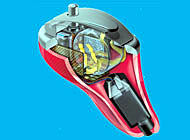Shrinking technology helps the hard of hearing

A Swiss company is helping to improve the quality of life for hundreds of thousands of people with hearing problems.
Phonak, based in Stäfa near Zurich, has created a range of “hearing computers”, which sit inside the auditory canal and imitate the function of healthy ears.
Although the company is still working on a micro scale (one thousandth of a millimetre), Phonak has been monitoring a Swiss nanotechnology roadshow, which recently wound up a visit to the United States.
The trip to Boston, Chicago and San Jose, California, was designed to cultivate contacts between scientists, investors and industry in the emerging field of technology at the nanometre scale. A nanometre is a millionth of a millimetre.
Shrinking technology
Microtechnology has made possible the tiny signal-processing chip for Phonak’s most sophisticated devices. The typical structures on the silicon are roughly one-fifth of a micrometre in size or, to be precise, 180 nanometres.
“Without the huge progress we have seen in microelectronics during the past five to ten years, the computational complexity of digital hearing instruments would not have been possible,” said Phonak’s head of research, Stefan Launer.
“Hearing instruments suffer from two technical constraints. We don’t have space, and because we don’t have space we don’t have very much power available in the system.
“If technology continues to shrink, we will see an improvement in the space required for the electronics and maybe other features of nanotechnology will also be used in hearing instruments.”
Sound quality
Launer said it was difficult to predict which aspects of nanotechnology could be beneficial.
“Nanotechnologies are in the research state and not yet available for the commercial products that we need.
“As regards electronics, we will make use of further technology shrinkage because that will save us a lot of space but we haven’t even started to look at all the mechanical and material aspects.”
Figures from Europe and the United States indicate that hearing impairment affects about ten per cent of the population.
Phonak technology has overcome one of the biggest problems for hearing-impaired people – unwanted background noise.
Sophisticated digital technology analyses the acoustic environment and continually regulates volume, clarity and sound quality.
Quality of life
“Hearing instruments have made really significant steps in the past five years and they have turned into extremely helpful and extremely complicated devices,” said Launer.
“They cannot completely solve the complex and difficult problem of hearing impairment but they can hugely improve quality of life.”
Six million hearing instruments are sold worldwide every year. Phonak, one of the top three manufacturers with annual production of 700,000 units, has a market share of 13 per cent.
Total sales of the Phonak Group in the 2000/01 financial year amounted to over SFr460 million.
by Vincent Landon

In compliance with the JTI standards
More: SWI swissinfo.ch certified by the Journalism Trust Initiative
You can find an overview of ongoing debates with our journalists here. Please join us!
If you want to start a conversation about a topic raised in this article or want to report factual errors, email us at english@swissinfo.ch.